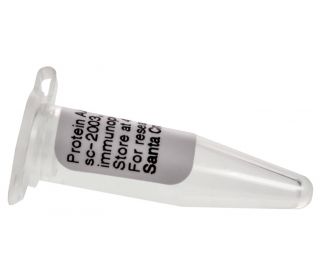Thermo Scientific™ RNase A, DNase and protease-free (10 mg/mL)
Catalog No :
CAS Number :
Brand :
In Stock
Specifications:
| Application | molecular biology | ||
| Storage Temperature | -20°C | ||
| Product Type | Enzymes | Forms | Liquid |
| Product Brand | Thermo Fisher Scientific™ | ||
| Product Grade | Molecular Biology | ||
Thermo Scientific™ RNase A, DNase and protease-free is a highly purified endoribonuclease enzyme that specifically degrades single-stranded RNA at C and U residues. This enzyme plays a critical role in RNA digestion, particularly for removing RNA from DNA preparations or protein samples during nucleic acid isolation procedures.
RNase A cleaves the phosphodiester bond between the 5'-ribose of a nucleotide and the phosphate group attached to the 3'-ribose of an adjacent pyrimidine nucleotide. The resulting 2', 3'-cyclic phosphate is hydrolyzed to form the corresponding 3'-nucleoside phosphate. This process makes RNase A essential for applications that require RNA degradation while ensuring the integrity of DNA during molecular biology procedures.
Key Features:
-
RNase A, DNase and Protease-Free:
- This enzyme is free from DNase and protease activity, ensuring that RNA is selectively cleaved without affecting DNA or proteins.
-
Specific for Single-Stranded RNA:
- RNase A cleaves single-stranded RNA at C and U residues, making it ideal for RNA removal from recombinant protein preparations or DNA.
-
Applications:
- Plasmid and genomic DNA preparation
- RNA removal from recombinant protein preparations
- Ribonuclease protection assays, used with RNase T1
- Mapping single-base mutations in DNA or RNA
-
Stable and Easy to Use:
- RNase A is active at a wide range of reaction conditions, making it versatile for various applications. It does not require pre-activation or heating.
-
Wide Range of Concentration:
- The recommended concentration of RNase A is 1 to 100 μg/mL, depending on the application.
-
Optimal for DNA/RNA Applications:
- At low salt concentrations (0 to 100 mM NaCl), RNase A cleaves single-stranded RNA, double-stranded RNA, and the RNA strand in RNA-DNA hybrids. At 0.3 M NaCl or higher, it specifically cleaves single-stranded RNA.
-
Storage and Stability:
- Store at -20°C for long-term stability.
Specifications:
| Feature | Details |
|---|---|
| Concentration | 10 mg/mL |
| Enzyme | RNase A |
| Purity | DNase-free, Protease-free |
| Quantity | 10 mg |
| Product Type | RNase A |
| Storage | Store at -20°C |
| Applications | DNA/RNA preparation, RNA removal, Ribonuclease protection assays |
Applications:
-
Plasmid and Genomic DNA Preparation:
- RNase A is widely used for removing RNA from DNA preparations, ensuring high-quality, RNA-free DNA.
-
Recombinant Protein Preparation:
- RNase A helps eliminate RNA contamination during the preparation of recombinant proteins, improving protein yield and purity.
-
Ribonuclease Protection Assays:
- RNase A is used in RNA protection assays, which help protect RNA sequences during analysis.
-
Mutation Mapping:
- Used in studies to map single-base mutations in DNA and RNA by ensuring complete RNA degradation without affecting the DNA.
-
Molecular Biology Applications:
- Ideal for general RNA digestion in molecular biology and genomics to facilitate downstream applications like PCR, cloning, and nucleic acid analysis.
Related Products:
- Thermo Scientific™ RNA Extraction Kits
- Thermo Scientific™ DNA Isolation Kits
- Thermo Scientific™ Protein Lysis Buffers
- Thermo Scientific™ RNase T1
Target Information:
RNase A is a nuclease enzyme that cleaves single-stranded RNA at C and U residues. It is derived from the bovine pancreas and has applications in various molecular biology techniques such as RNA isolation, DNA/RNA purification, and RNA removal.
The Thermo Scientific™ RNase A, DNase and Protease-Free is an essential tool for RNA removal, DNA/RNA extraction, and protein preparation. With its high purity, stability, and broad application range, it is ideal for use in molecular biology and genomics studies. It ensures clean, high-quality nucleic acids for downstream applications like PCR, sequencing, and cloning.




 0
0
